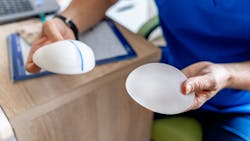UCLA scientists developing test to detect breast implant ruptures
Amid growing scrutiny of breast implant safety, a pair of UCLA scientists are developing a lab test aimed at detecting silicone implant ruptures which they think may also help explain why many women who received implants have later reported a constellation of systemic symptoms.
The Food and Drug Administration recently elevated safety warnings over breast implants after collecting reports from hundreds of thousands of women about a novel cancer and other chronic conditions, like brain fog, joint pain and fatigue. While regulators have said more research is needed into what’s possibly causing a range of symptoms that’s been unofficially termed “breast implant illness,” the silicone used in implants is seen as a possible culprit.
Kym Faull, a professor of psychiatry and biobehavioral sciences at the Jane and Terry Semel Institute for Neuroscience and Human Behavior at UCLA, and Dr. Michael DeLong, an assistant professor-in-residence in plastic and reconstructive surgery at UCLA Health, have been working on a test that can measure silicone metabolites in patient blood and urine samples – a potential revolution in how breast implants are monitored for safety.
Roughly 300,000 patients undergo breast augmentation surgery each year in the United States, the vast majority of which are performed with silicone gel-filled implants. While rupture rates are thought to be low, the risk increases as the implants age and most ruptures in silicone implants are thought to be “silent,” or asymptomatic.
The only way to confirm an implant rupture or leak is through surgery to visualize the implant, although MRI studies are non-invasive and can be relatively accurate. While the FDA recommends regular screenings for patients with silicone implants, historically very few patients have followed this recommendation.
As breast implant safety gained growing attention, DeLong sought Faull’s help to develop a lab test to detect silicone metabolites, hoping it would be cheaper, more accurate and less involved than the MRI procedure currently in use.
This work, being conducted at the Semel Institute’s Pasarow Mass Spectrometry Laboratory overseen by Faull, could potentially be applied clinically for identifying breast implant ruptures and help provide sought-after answers about breast implant safety.

